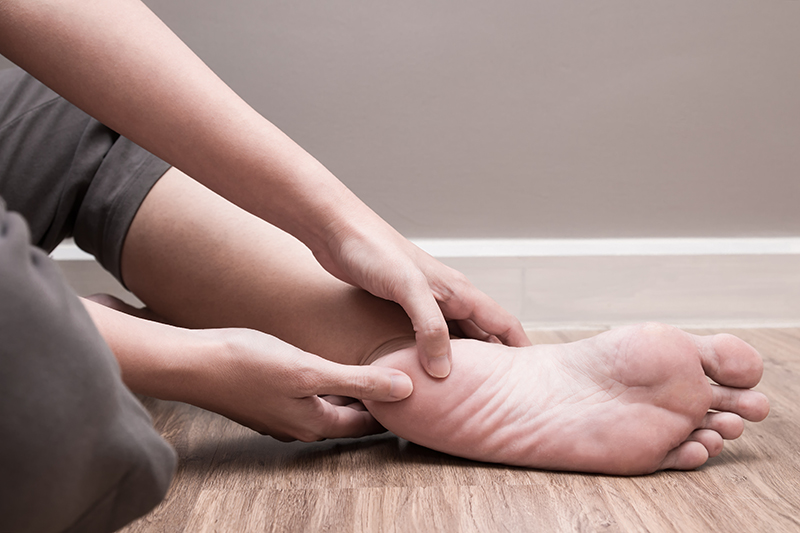Heel Pain
Heel pain is a common orthopedic complaint that can significantly impact mobility and quality of life. Understanding its causes, treatments, and when to seek medical advice is crucial for effective management.

CAUSES
- Plantar Fasciitis: The most common cause, characterized by inflammation and microtears of the plantar fascia. The plantar fascia a thick band of tissue that runs across the bottom of the foot that is a continuation of the Achilles tendon.
- Achilles Tendinitis: Inflammation of the Achilles tendon and/or paratenon (ie, very thin cellular layer that surrounds the Achilles tendon and nourishes the Achilles tendon), which connects the calf muscles to the heel bone.
- Heel Spurs: Bony growths on the underside of the heel bone originating from chronic inflammation and/or trauma, often associated with plantar fasciitis.
- Stress Fractures: Small “hairline” cracks or breaks in the bones of the foot, typically caused by repetitive stress or overuse.
- Bursitis: Inflammation of the bursa, a fluid-filled sac that cushions the heel bone and is present over all bone prominences in our body.
- Tarsal Tunnel Syndrome: Compression of the tibial nerve as it passes through the tarsal tunnel, located on the inside of the ankle, similar to “carpal tunnel” but Tarsal Tunnel refers to nerve compression for the foot and ankle.
- Rheumatoid Arthritis: An autoimmune disorder that causes inflammation (AKA synovitis) and pain in the joints, including the heel.
- Gout: A type of arthritis caused by the crystallization of uric acid crystals in the joints, leading to sudden and severe pain in the heel or other joints.
- Calcaneal Apophysitis (Sever’s Disease): A common cause of heel pain in children, caused by inflammation of the growth plate in the heel bone.
Treatments
- Rest: Avoid activities that exacerbate the pain, such as running or standing for long periods.
- Ice: Apply ice packs to the affected area for 15-20 minutes several times a day to reduce inflammation.
- Stretching: Perform gentle stretching exercises for the calf muscles and plantar fascia to improve flexibility and reduce tension. Physicial therapy is crucial to teach and ensure you are stretching appropriately to avoid further injury.
- Orthotics: Custom or over-the-counter shoe inserts can provide mechanical support and cushioning to alleviate pressure on the heel.
- Physical Therapy: A physical therapist can recommend specific exercises and techniques to strengthen the muscles and improve mobility and provide an excellent personalized home exercise program.
- NSAIDs: Nonsteroidal anti-inflammatory drugs (NSAIDs) like ibuprofen or naproxen can help reduce pain and inflammation.
- Corticosteroid Injections: In severe cases, a corticosteroid injection may be administered to reduce inflammation and pain.
- Night Splints: Wearing a night splint can help stretch the plantar fascia and Achilles tendon while sleeping.
- Extracorporeal Shockwave Therapy (ESWT): This non-invasive treatment uses shockwaves to stimulate healing and reduce pain.
- Compound Topical Medication: A variety of options available but is a good alternative to taking systemic medications. (eg, CBD topical cream)
If heel pain persists or is severe despite trying conservative home care, it is important to seek medical advice to determine the cause and appropriate treatment.
- Persistent Pain: If heel pain persists for more than a 4-6 weeks despite rest and home remedies.
- Severe Pain: If the pain is severe and interferes with daily activities.
- Swelling or Redness: If the heel is swollen, red, or warm to the touch.
- Fever or Chills: If you experience fever or chills along with heel pain, as it could indicate an infection.
- Numbness or Tingling: If you experience numbness or tingling in the heel or foot.
SURGERY
In rare cases where conservative treatments fail, surgery may be necessary for heel pain and is typically considered only after conservative treatments have failed to provide relief. In cases of severe recalcitrant plantar fasciitis or heel spurs that do not respond to conservstive treatments, surgical options may include plantar fascia release, removal of the heel spur or calf lengthening (eg, endoscopic gastrocnemius recession).
